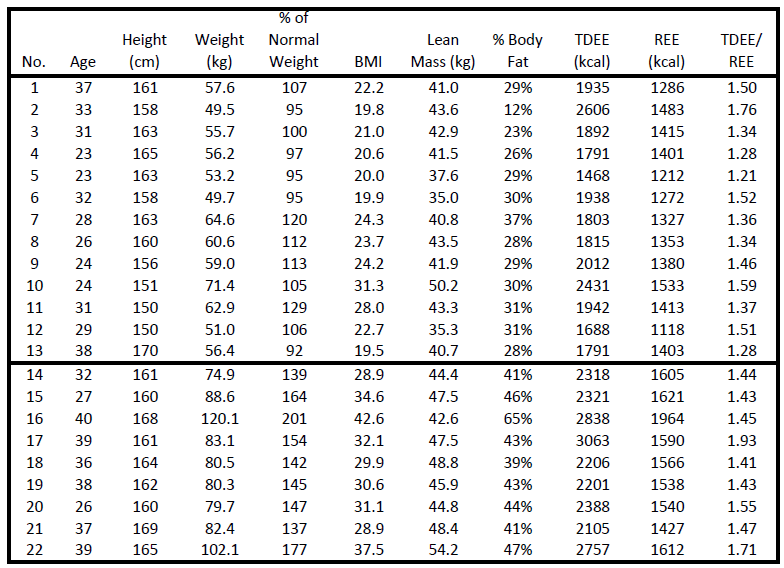Energy Expenditure Correlations to Various Factors in Women
I'm working on a post to tie together some thoughts on calories and what "appropriate" intake generally is for women. In doing so I came across the following study -- High levels of energy expenditure in obese women -- crunched some of the data into a giant Excel table, and did a few linear regression analyses. I'm certainly not attempting to create yet another model for all of this, but I did find some interesting things.
The full text is free, so you can read methods, but they measured body composition, REE and TDEE by the doubly labeled water method. They had 22 women in the study, 13 normal/lean and 9 obese. For this post, I just plotted all 22 data points for each comparison. Here are the plots for resting metabolic rate vs. various parameters.
What I found interesting was that, for these 22 women, including all data points in the regression the best fits were for the most crude measures: total weight and BMI. The lean mass and percent body fat show quite a bit more scatter about the fit line. For example, at about 30% fat, you have women ranging from 1100 to about 1550 cal/day. That outlier in the LBM plot is not an error and wasn't the 12% body fat lady either. Oddly you seem to have more variability in the rates for the smaller women. But again, you've got quite a bit of scatter.
Since it's right up top of this, let's look at the REE vs. BMI plot. At a BMI of about 20 you have REE's that range from 1200 - 1500 cal/day. Alternately you have women with REE of 1400 ranging from about 20 to 29 BMI, or at 1600 cal ranging from about 29 up to BMI of almost 38.
Since it's right up top of this, let's look at the REE vs. BMI plot. At a BMI of about 20 you have REE's that range from 1200 - 1500 cal/day. Alternately you have women with REE of 1400 ranging from about 20 to 29 BMI, or at 1600 cal ranging from about 29 up to BMI of almost 38.
Now for TDEE:
The correlation is slightly better for weight than lean mass. How about % body fat? At 30% you go from 1400-2400, at around 45% from 2000-3000 cal/day.
Percent of ideal weight, oddly enough, tightens up with the same couple of data points spoiling an otherwise rather tight scatter.
Height is a bust on its own
The best correlation for TDEE? BMI!! Considering again the two spoilers, the scatter is even more "impressive". One of the spoilers is the woman with 12% body fat who is likely an athlete, the other is not out of the ordinary in terms of any parameter.
Again, I'm not really trying to make anything out of these plots other than to park some data that I'll refer to in an upcoming post and put a visual to the correlations. I would note a few things here:
- The normal weight women by BMI standards had TDEE's ranging from 1400 cal/day to 2000 cal/day with the exception of the one woman who had 12% body fat and a TDEE/REE ratio of 1.76 which is "active".
- Half of the women had TDEE of roughly 2000 cal/day or less, of the half of women with TDEEs over 2000 calories, only one had a BMI in the normal weight range (again, the 12% BF).
- I repeat the table below again. The normal weight women had TDEE/REE ratios ranging from 1.21 to 1.76, with the next highest ratio below that being 1.59. Only about half had ratios above 1.4. All of the obese women had a ratios over 1.4 with 7 of 9 in the in the 1.4 to 1.55 range, a 1.71 and a 1.93. Thus ...
- Obese women appear to expend more energy moving around compared to energy spent to "maintain function" because on average (other study) the obese tend to move less. This is something I'll look into a bit more and put some thoughts together about.
I think this last point may present yet another issue and may be responsible for some perceived reduction in metabolic rate vs. lean or total mass alone. I hope to address this in more comprehensive fashion shortly.














Comments
Post a Comment
Comment Moderation is ON ... I will NOT be routinely reviewing or publishing comments at this time..